Welcome to our comprehensive month-by-month operations guide for fig/anjeer fruit orchards! Growing figs, also known as anjeer, can be rewarding and profitable. These delicious fruits are nutritious and have a unique taste and texture that is highly sought after in the market. To ensure a successful fig orchard, it is crucial to understand and follow the appropriate management practices throughout the year. In this guide, we will take you through the key operations and tasks that must be performed each month to maximize the yield and quality of figs.
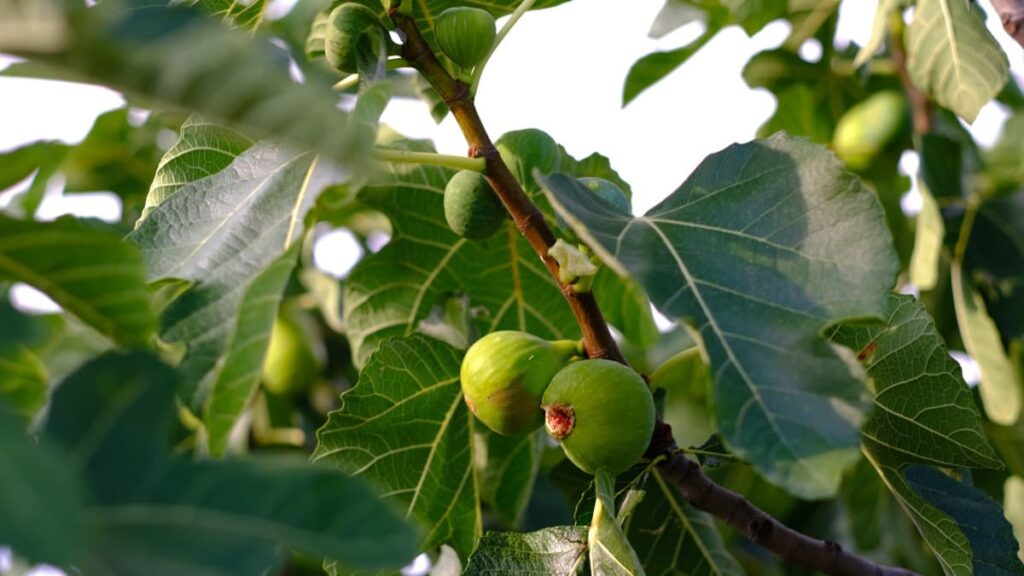
Fig/Anjeer Orchard Management
What is Fig/Anjeer Farming and its Overview?
The fig fruit, Ficus carica, is an ancient fruit cultivated in the eastern Mediterranean region from 3000-2000 BC. Unlike most fruits, the Fig’s edible structure is a stem tissue called a syconium, which contains the remains of the flower structure at maturity. Figs are consumed fresh or dried, with the dried form being more popular, comprising about 80% of fig consumption. They are delicious, nutritious, and rich in calories, protein, calcium, and iron. Figs are also known for their laxative and medicinal properties and are used topically for skin infections.
- It is a Moraceae family member and is eaten dry worldwide. One of the oldest fruits, figs, are native to the Middle East and Western Asia.
- In addition to its culinary uses, the Anjeer fruit is believed to possess medicinal properties and holds significance in Indian mythology.
- The low-maintenance tree can be grown outdoors or in pots and containers. It features smooth silver-greyish bark and distinct leaves around 4 inches long with 3-5 lobes on each leaf. Anjeer trees can reach a height of up to 9 meters.
- The Anjeer fruit is pear-shaped or top-shaped, measuring approximately 1 to 4 inches long. It has a mild, sweet flavor that is highly enjoyable.
- Turkey produces 30% of the world’s one million tons of figs, a reasonably important fruit crop. Egypt, Morocco, Greece, California, Italy, Algeria, Syria, and Tunisia are important producers.
- Fig is a small fruit crop in India, predominantly grown in Western Maharashtra, Gujarat, Uttar Pradesh (Lucknow & Saharanpur), Karnataka (Bellary, Chitradurga & Srirangapatna), and Tamilnadu (Coimbatore).
In case you missed it: The Ultimate Month-by-Month Guide to Custard Apple Orchard Management
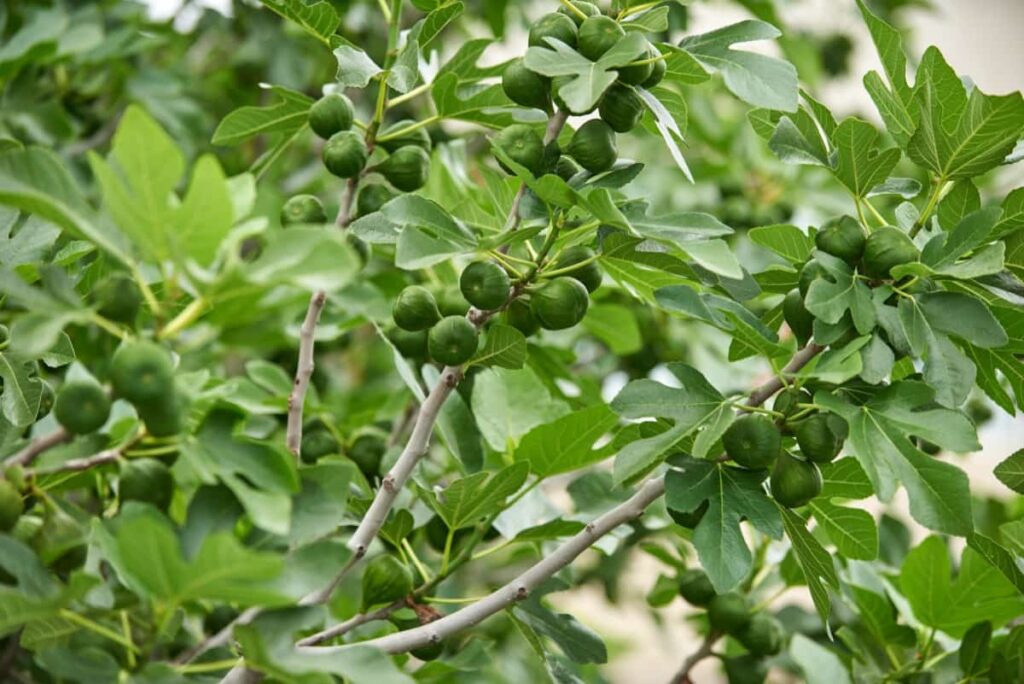
Best Tips for Anjeer Fruit Orchards Package and Practices
Sunlight & Temperature Requirement
- Fig trees thrive in arid or semiarid environments with high summer temperatures and sunshine.
- The ideal temperature range for fig growth is between 15°C and 21°C, although they can withstand higher temperatures up to 45°C.
- Dry climates during fruit development and maturity are favorable for quality fig production.
- High humidity combined with low temperatures can lead to fruit splitting and reduced fruit quality.
The Best Soil for Growing Anjeer
- Well-drained, fertile soil rich in organic matter is ideal for fig trees.
- Soil pH should be between 6-8 for Fig.
- Ensure the soil retains some water for fruit growth.
- Fig is a salt and drought-tolerant crop, preferring medium to heavy, calcareous, well-drained soil with a pH of 7-8.
Varieties of Fig
- Approximately 20 popular fig varieties are grown worldwide, with different regions favoring specific cultivars.
- Some well-known varieties include ‘White Adriatic,’ ‘Black Mission,’ ‘Kodota,’ and ‘Conadira’ in California; ‘Kalamon’ in Greece; and ‘Sultani’ in Egypt.
- In India, ‘Poona’ is a popular cultivar grown for fresh consumption, while ‘Dinkar’ is gaining commercial importance as an improved variety.
Container/Pot Selection
Use a pot 17-20 inches deep, preferably clay or terracotta, for better air and water exchange.
Planting of Anjeer
- Figs are planted in 5 × 5 m squares with 160 plants per acre. Planting cuttings requires 0.6 cubic meter pits.
- South India plants August–September, Western India June–July, and North India January–February.
Anjeer Tree Flowers
- Flowers are yellowish-green or coppery in color.
- Bloom from February to May.
Harvesting Fig Fruits
- Harvest fig fruits from June to September.
- Young figs are green and mature into a purple color.
- The flesh inside the Fig is always red.
- Fruits typically appear two years after planting, with continuous production in the tropics and twice a year in colder regions.
In case you missed it: Optimizing Cashew Orchard Management: A Month-by-Month Operation Guide for Maximum Yield
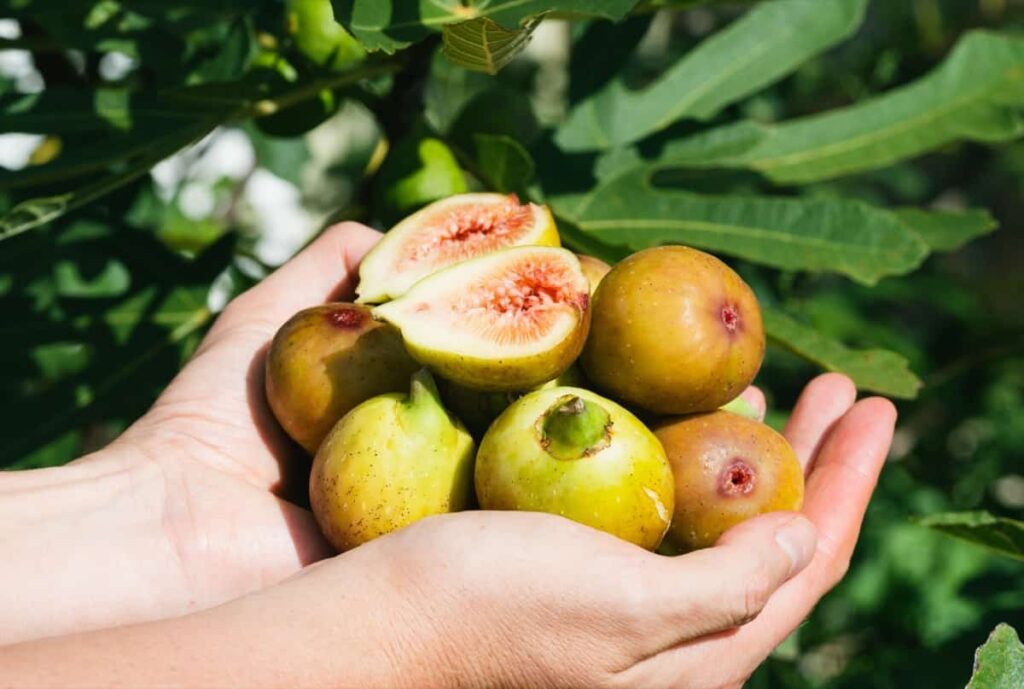
Eating Anjeer or Fig Fruit
- Fig fruits can be eaten fresh or used in various recipes.
- They can be consumed in dry form as well.
Propagation of Anjeer Plant
- Propagation of fig trees can be done through cuttings, seeds, air layering, budding, and grafting.
- Propagation methods include cuttings, seeds, and layering.
- Cuttings should be buried 4-5 inches deep in potting soil.
- Seeds can be soaked in lukewarm water before sowing.
- Leaves should start appearing within 2-3 months.
Pruning a Fig Tree
- Light pruning is sufficient to maintain shape and induce new growth.
- Remove suckers from young plants and dead or broken parts from mature plants.
- Fig trees are trained to a desired height and shape for increased productivity and easier inter-cultivation.
- Pruning is necessary to stimulate the growth of flower-bearing wood.
- Light pruning is typically performed in October after the monsoon season.
Watering Fig Tree
- Regular watering is required, keeping the soil moist but not waterlogged.
- Reduce watering frequency in winter and irrigate when the top soil feels dry.
- Fig trees can withstand heat and drought but require timely irrigation for commercial production.
- Flood irrigation at intervals of 10-12 days during summer is suitable, but drip irrigation can also be used with approximately 15-20 liters of water per day per plant.
Fertilizing Fig Tree
- Apply organic fertilizers monthly during the growing season.
- Vermicompost or cow-dung compost can be used.
- Alternatively, use a 5-5-5 NPK fertilizer.
- Recommended fertilizer dosages vary depending on the tree’s age, with increasing quantities of farmyard manure (FYM), neem cake, nitrogen, phosphorus, and potassium over time.
- Anjeer farming is practiced in states like Gujarat, Maharashtra, Uttar Pradesh, Tamil Nadu, and Karnataka in India.
- The plantation is done from June to September, with approximately 150 plants per acre.
Diseases & Pests
- Remove dead or damaged parts to prevent the spread of infection.
- Common pests include spider mites, aphids, whiteflies, leaf defoliators, stem borers, and fig flies.
- Treat fig flies with Demecron and stems borers with Phorate mixed with Kerosene.
- Neem oil or eucalyptus oil spray can be used for insect control or spray water to remove pests.
- Common pests of fig trees include stem borers, leaf defoliators, and fig flies.
- Control measures include using Demecron spray for fig flies and applying Phorate granules with petrol or Kerosene for stem borers.
- Rust caused by Cerotelium fici is a significant disease that can be controlled through sulfur dusting or spraying with appropriate fungicides.
In case you missed it: Optimizing Sapodilla/Sapota Orchard Management: A Month-by-Month Operation Guide for Maximum Yield
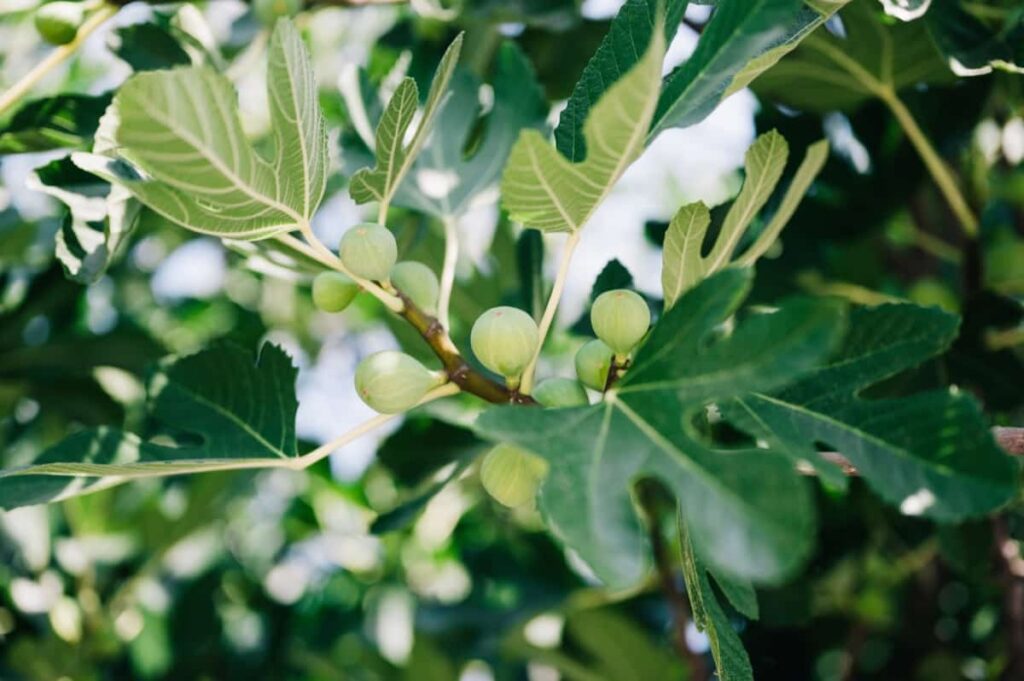
Fruit Set, Harvesting, and Yield
- Parthenocarpy, the phenomenon of fruit development without pollination, can be enhanced by applying growth regulators like NAA or IBA.
- Commercial harvesting begins in the third year, with ripe figs picked when soft and wilt at the neck.
- Fresh figs are highly perishable and can be stored for a week at 0°C with 90% relative humidity.
- Yield per tree increases with the age of the plant, ranging from 3 kg in the third year to 18 kg in the eighth year and beyond.
January Month Fig/Anjeer Orchard Operations Planning
- Prune fig trees to maintain their shape and size.
- Fertilize fig trees with a balanced fertilizer.
- Water fig trees regularly, especially during dry weather.
- Inspect fig trees for pests and diseases.
February Month Fig/Anjeer Orchard Operations Planning
- Water the plants at 8 to 10 days intervals regularly.
- Apply Bordeaux Paste on the trunk up to 30 to 45 cm height to avoid the frequent incidence of termites and other fungal diseases.
- Monitor the trees for pests and diseases.
March Month Fig/Anjeer Orchard Operations Planning
- Water the plants at 8 to 10 days intervals regularly.
- Apply one basket of dry leaf mulch or paddy straw to control evapotranspiration loss and weed growth in basins.
- Prune the trees to remove dead, diseased, or damaged branches.
- Fertilize the trees with a balanced fertilizer.
April Month Fig/Anjeer Orchard Operations Planning
- Irrigation: Ensure regular irrigation through drip or basin irrigation at least once every 5 to 7 days.
- Soil preparation: Hoeing and mulching should be done to keep the soil loose and friable. Ensure the soil suitability by digging up a profile pit of 3 X 3 X 3 ft. plant to plant 5 x 5 m distance. Observe the soil for the presence of any calcareous nodules or sheetrock. If lime nodules or sheetrock are present, avoid such soils for taking up plantations.
- Soil testing: Collect soil samples for every one-foot depth of soil from the profile pit dug out and send the sample for analysis to the nearest soil testing lab.
- Soil pH: Based on the soil test report, even if the soil pH is moderately high (8.0 to 8.5), it is considered suitable for a fig/anjeer plantation.
- Subsurface water table: The subsurface water table in the soil should be below 2.5 Mts.
May Month Fig/Anjeer Orchard Operations Planning
- Plow the land: Plough the land with a moldboard. Plow two to three times to get fine tilth and level the land.
- Mark the pits: Mark the pits at 5×5 m in light soils and 7×7 m in heavy soils. Accommodating about 150-160 plants per acre. Pits of 0.6 cu.m are dug for planting the cuttings.
- Dig the pits: Dig the pits to a depth of 90 cm. Keep the top 1.5 feet of soil to the right side of the pit and the bottom 1.5 feet of soil to the left side of the pit. Allow the pits to expose to the sun for at least two weeks before filling them.
- Fill the pits: Fill the pits with a mixture of topsoil, compost, and manure.
- Procure plant material: Make arrangements to procure plant material from a reliable nursery.
In case you missed it: Optimizing Coconut Orchard Operations: A Comprehensive Management Guide for Month-wise Planning
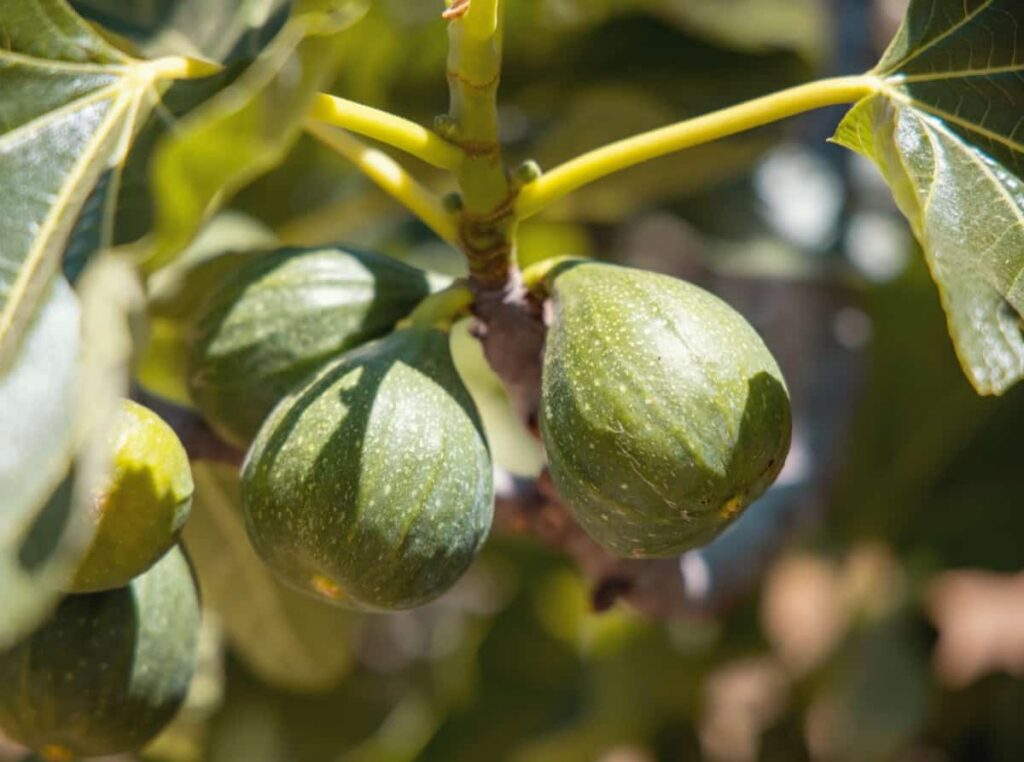
June Month Fig/Anjeer Orchard Operations Planning
- Pit filling: Fill the pits with topsoil mixed with 50 kgs of Farm Yard Manure (FYM) + 1 kg Single Super Phospate + 1 kg Neem Cake and 100 gm. Of 10% Follidol dust per pit. Fill the pits with the soil at least 6″ above the ground level so that it will be at the ground level at planting when the soil settles.
- Fencing: Ensure thorn fencing or any thick growing live fence to control cattle trespassing.
- Drip installation: Give a mark out for trench cutting and complete the trench cutting for drip installation. With the onset of the monsoon, farmers can sow intercrops.
July Month Fig/Anjeer Orchard Operations Planning
- Procure plant material. Select grafts/plants at least one-year-old with 4 to 6 flushes of 50 to 75 cm height. The graft union should be perfect and at least 15cm above the soil in the poly bag. The sapling should be healthy and free from pests and diseases without any side shoots on the rootstock.
- Transport plant material. Keep the saplings near a water source and water them regularly until planting is done.
- Prepare planting site. If there are good rains, the pits should be soaked by giving irrigation or by running the drip system. Ensure that the soil in the pit is at ground level.
- Plant saplings. Remove the polythene sheet carefully from the graft union and plant by keeping the sapling in the center of the pit without disturbing the earth ball around the root system. Ensure the graft union is 6 inches above the ground level after planting.
- Stake saplings. Stake the plant with a strong support stick 3 to 4 feet long. Dip the bottom of the stick in black tar to avoid a termite attack.
- Water saplings. Water the plant immediately after planting. Irrigate the plants every 7 to 10 days intervals.
August Month Fig/Anjeer Orchard Operations Planning
- Weeding should be done at least once every two months during the monsoon season to control weeds.
- The interspaces should be plowed with a blade harrow or cultivator to keep the land weed-free.
- To avoid evapo-transpiration losses, the basins should be mulched with paddy husk, straw, or groundnut shells. Mulching also helps in the control of weeds in the basins.
- Side shoots that appear on the rootstock should be removed.
September Month Fig/Anjeer Orchard Operations Planning
- If a termite attack is seen on the support stick, spray Chloropyriphos of water on the stem and support stick. Also, drench the basins with the above chemical.
- Prune the side branches arising from the main trunk at ground level.
October Month Fig/Anjeer Orchard Operations Planning
- If any gaps are noticed due to the death of plants, replant by taking up gap filling.
- Remove the side shoots which appear on the rootstock.
- In high rainfall zones, planting can be done in October-November.
- If intercrop during June-July is not cultivated, farmers can sow intercrops for the rabi season during this month.
- Apply about 100 gms of DAP in the basins and irrigate immediately.
November Month Fig/Anjeer Orchard Operations Planning
- Gap filling: If any gaps are noticed due to the death of plants, replant by taking up gap filling.
- Soil working: Soil working in the basins and mulching with dry leaves or paddy straw to control evapo-transpiration losses and weed growth.
- Remove the side shoots: Remove the side shoots which appear on the rootstock.
- Water the plants: Water the plants regularly at 8 to 10 days intervals.
December Month Fig/Anjeer Orchard Operations Planning
- Pruning: Prune the fig trees to remove dead, diseased, or damaged branches. You can also prune the trees to shape or control their size.
- Mulching: Apply a layer of mulch around the fig trees to help suppress weeds and conserve moisture.
- Watering: Regularly water the fig trees, especially during dry winter.
- Fertilizing: Fertilize the fig trees with a balanced fertilizer in the early spring.
- Protecting from pests and diseases: Monitor the fig trees for pests and diseases and take steps to control them if necessary.
In case you missed it: Optimizing Mango Orchard Operations: A Comprehensive Guide for Month-wise Planning
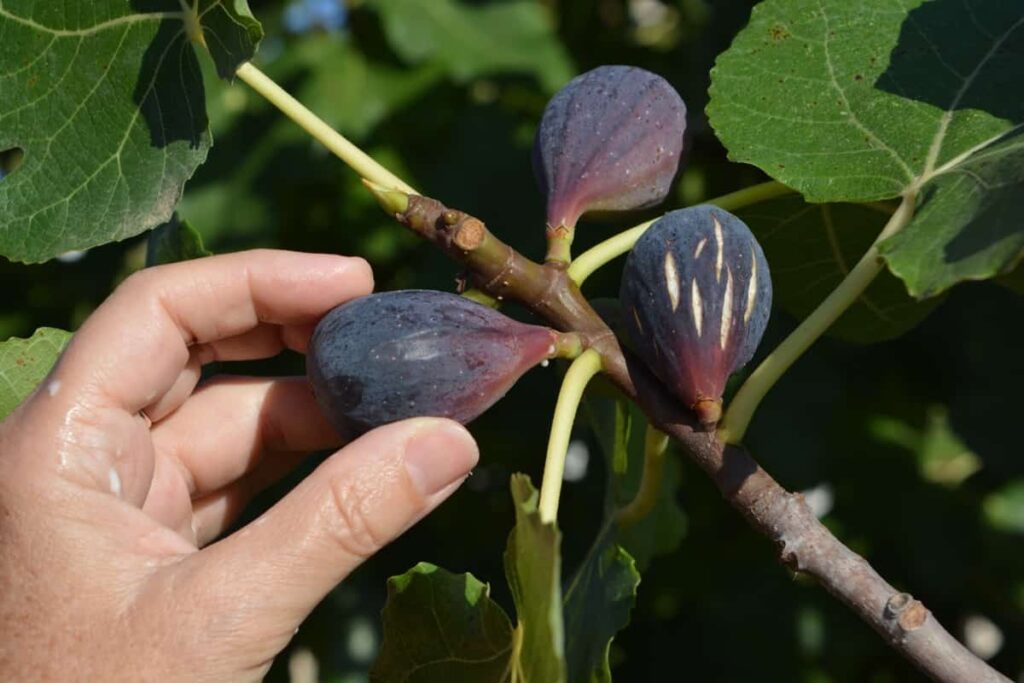
Conclusion
Successful fig orchard management requires careful attention to climate, soil, propagation, irrigation, training, pruning, plant protection, and timely harvesting to ensure optimal yield and fruit quality.
- Management Pests and Diseases in Your Cotton Field
- Sheep Farming Business Plan for Beginners
- Aquaponic Farming at Home: A Step-By-Step Guide
- Profitable Village Farming Business Ideas in 2024
- High-Yield Aquaculture: Fast-Growing Fish for Farming
- Effective Fish Pond Construction Techniques for Beginners
- Irrigation and Water Management in Pineapple Farming
- Blossom to Harvest: Mastering Flowering and Pollination in Papaya Farming
- Pig Fattening Essentials: From Selection to Sale for Beginners
- Raising Wagyu Cattle: A Complete Guide for Premium Beef Production
- Soil Types and Their Water Holding Capacity
- Optimizing Irrigation Schedules for Coconut Groves for Enhanced Yield
- Espresso Your Garden: Coffee Grounds for Healthier Acid-Loving Plants
- The Best Soil Mix for Snake Plants: How to Mix Your Own Snake Plant Soil
- Green Thumb Success: Expert Tips for Cultivating Greenhouse Beans All Year Round
- Bloom All Year Round: The Ultimate Guide to Indoor Hyacinth Care
- Eco-Friendly Gardening: How to Make Liquid Fertilizer from Kitchen Waste
- Ultimate Guide to Grow Anise in Pots: Explore Seed Propagation to Harvesting
- Guide to Raising Chester White Pigs: Discover Breed Facts to Growth Management
- Mastering the Elegance: The Ultimate Guide to Weeping Cherry Tree Care, Planting, and Maintenance
- Ultimate Guide to Planting Garlic in Grow Bags: Growing Strategies for Beginners
- How to Fix Spider Plant Leaf-Related Problems: Natural and Organic Remedies
- 10 Reasons Why Your Tulsi Plant is Shedding Leaves: Home Remedies and Solutions
- Optimizing Growth and Yield: The Advantages of Palm Bunch Ash Fertilizer
- Utilizing Neem Oil Extract as a Natural Pesticide for Hydrangea
- From Soil to Harvest: Various Ways in Which Farmers Can Use AI Tools
- Steps to Encourage and Induce Citrus Flowers: A Comprehensive Guide
- How to Fix Snake Plant Leaf-Related Issues: Natural and Organic Remedies
- Transform Your Garden into a Fragrant Oasis with Raat Ki Rani (Night Blooming Jasmine)
- Discover the Ideal Chicken Breeds for Philippine Farms
- How to Create a Poultry Egg Farm Business Plan for Profits
- Grow Lemon Cucumbers Like a Pro: Insider Techniques for Bountiful Yields
- Ultimate Guide to Caring for Your Pink Princess Philodendron: Tips for Thriving Variegation
- Areca Nut Profit Per Acre: Calculating Yield and Cost of Cultivation
- How Kaveri Chicken is Becoming a More Profitable Breed in Indian Backyards
- Transform Your Barn: 9 Steps to Convert a Horse Stall into a Chicken Coop
